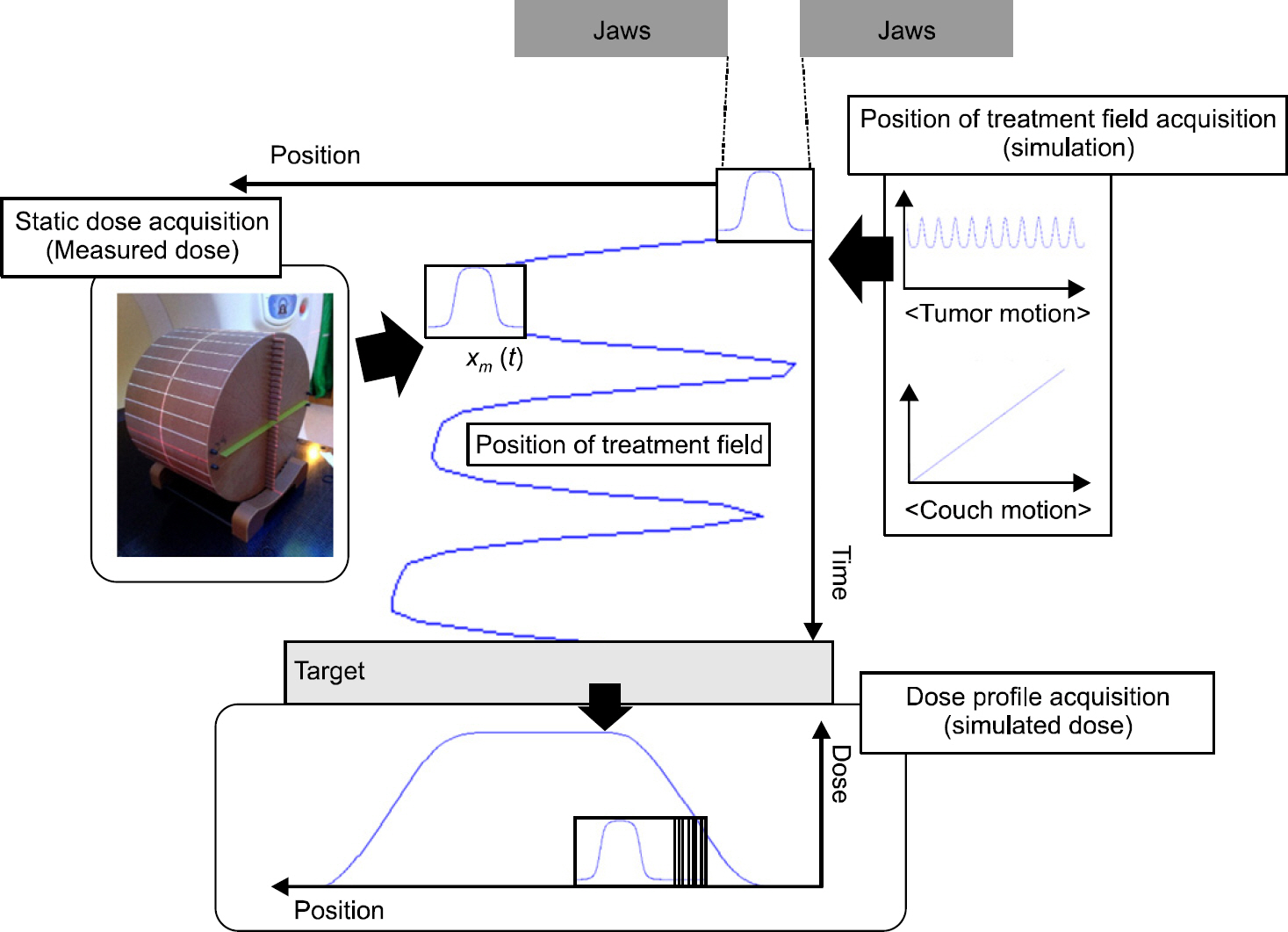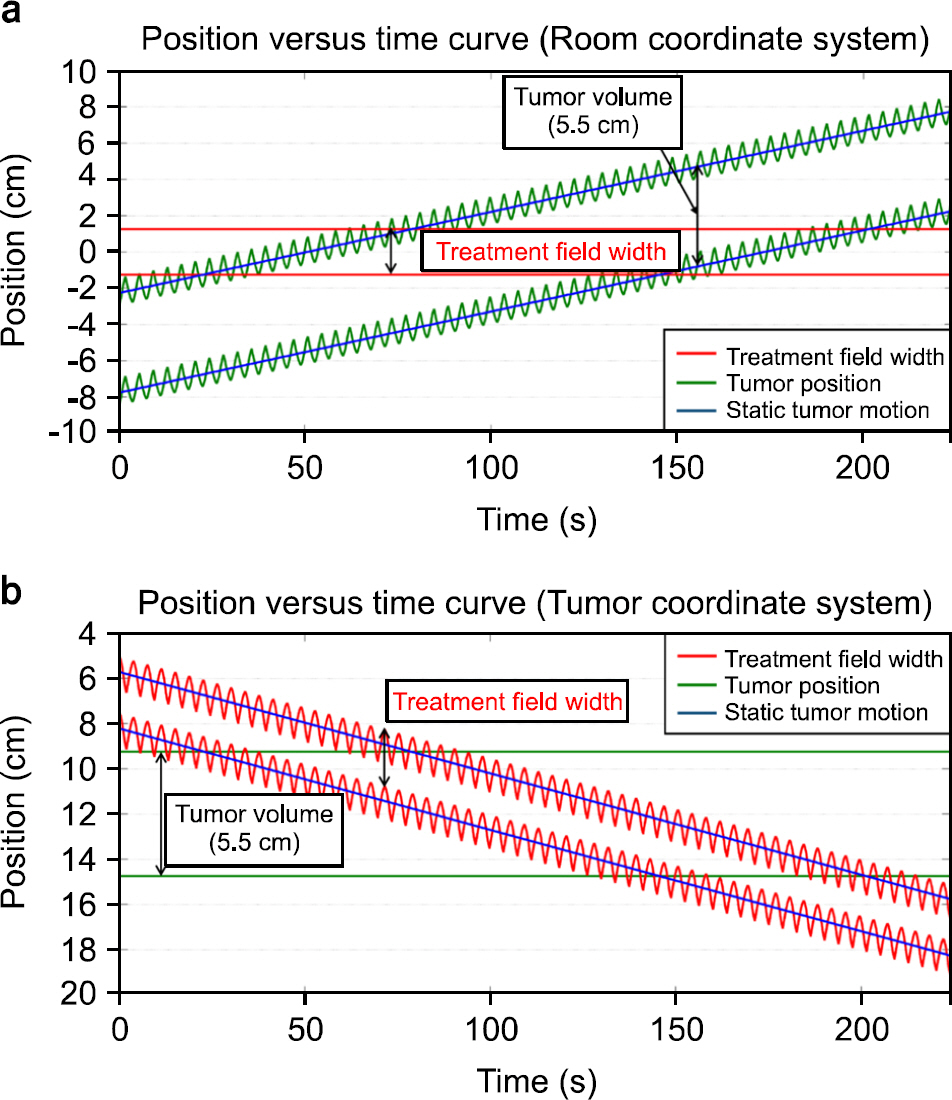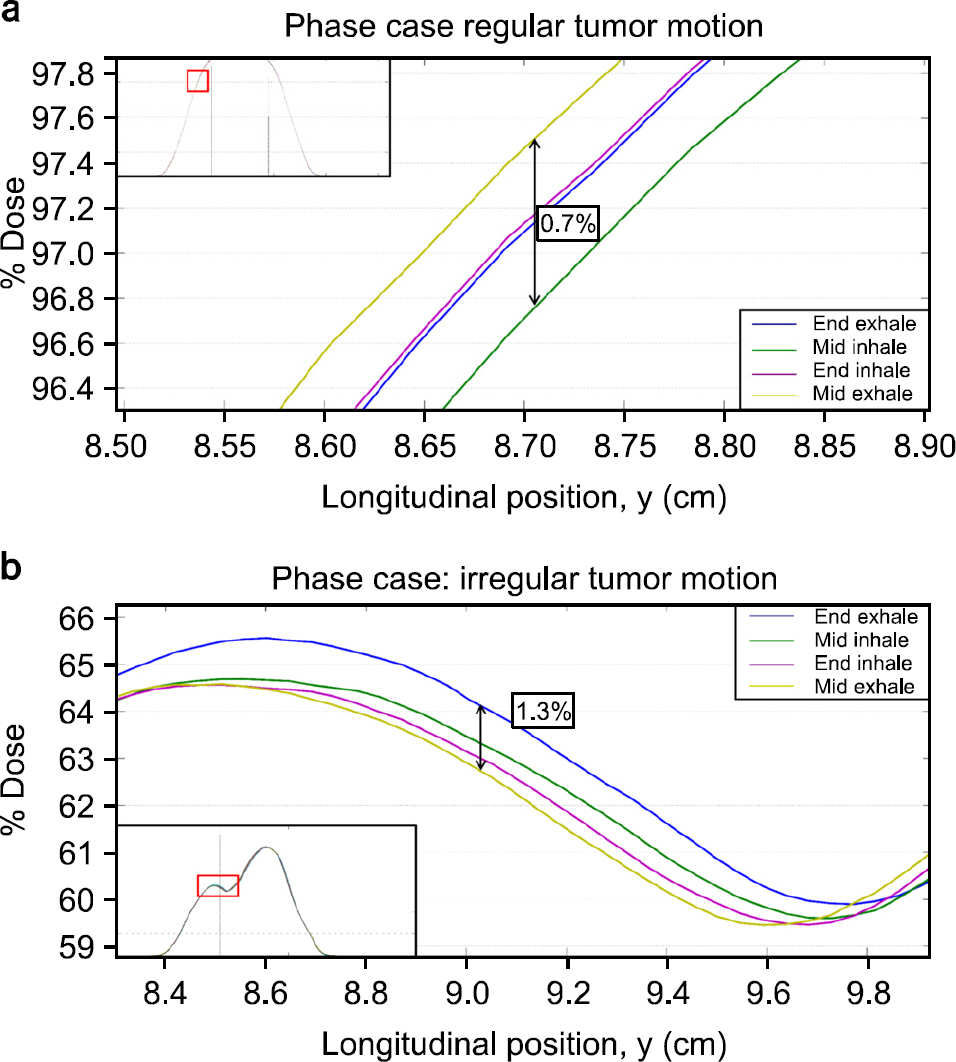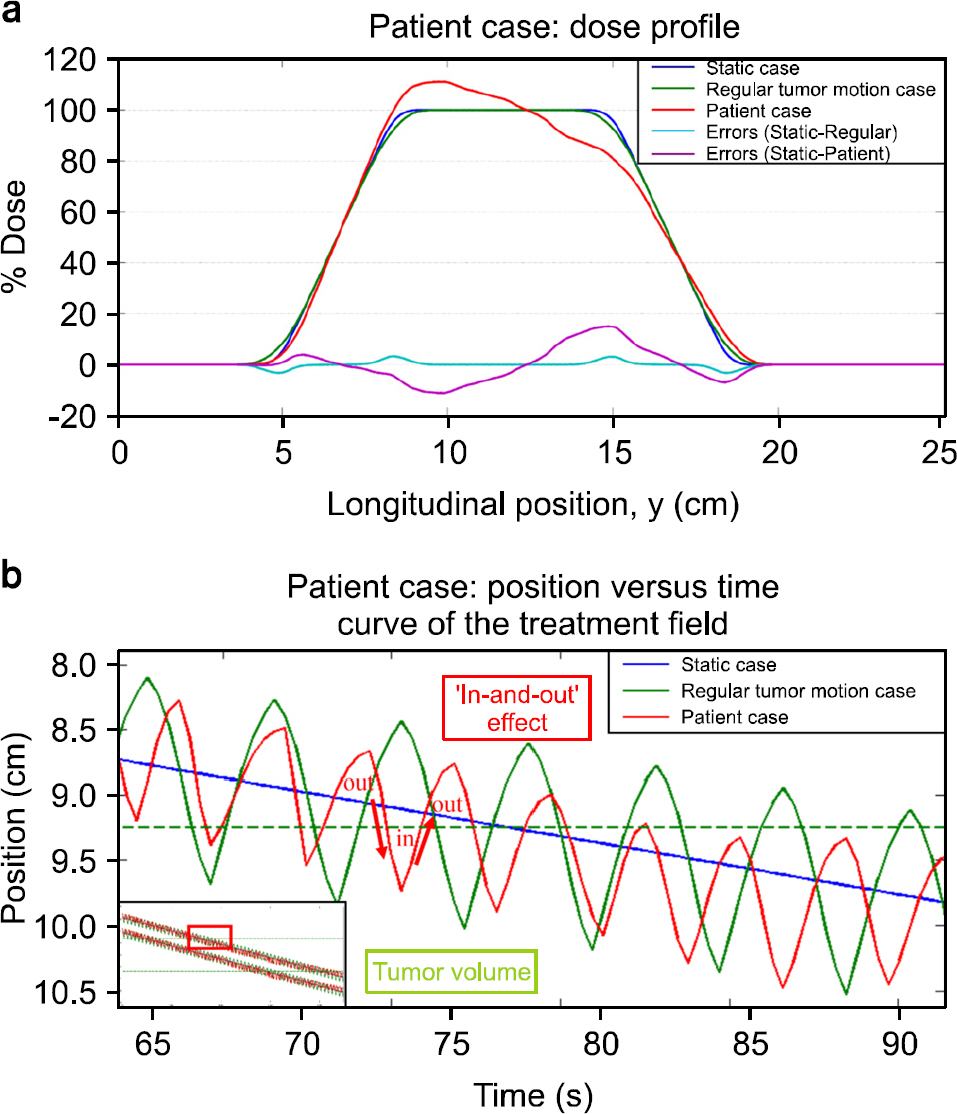Prog Med Phys.
2015 Sep;26(3):119-126. 10.14316/pmp.2015.26.3.119.
Study of Motion-induced Dose Error Caused by Irregular Tumor Motion in Helical Tomotherapy
- Affiliations
-
- 1Department of Biomedical Engineering, The Catholic University of Korea, Seoul, Korea. suhsanta@catholic.ac.kr
- 2Research Institute of Biomedical Engineering, College of Medicine, The Catholic University of Korea, Seoul, Korea.
- KMID: 2069474
- DOI: http://doi.org/10.14316/pmp.2015.26.3.119
Abstract
- The purpose of this study is to analyze motion-induced dose error generated by each tumor motion parameters of irregular tumor motion in helical tomotherapy. To understand the effect of the irregular tumor motion, a simple analytical model was simulated. Moving cases that has tumor motion were divided into a slightly irregular tumor motion case, a large irregular tumor motion case and a patient case. The slightly irregular tumor motion case was simulated with a variability of 10% in the tumor motion parameters of amplitude (amplitude case), period (period case), and baseline (baseline case), while the large irregular tumor motion case was simulated with a variability of 40%. In the phase case, the initial phase of the tumor motion was divided into end inhale, mid exhale, end exhale, and mid inhale; the simulated dose profiles for each case were compared. The patient case was also investigated to verify the motion-induced dose error in 'clinical-like' conditions. According to the simulation process, the dose profile was calculated. The moving case was compared with the static case that has no tumor motion. In the amplitude, period, baseline cases, the results show that the motion-induced dose error in the large irregular tumor motion case was larger than that in the slightly irregular tumor motion case or regular tumor motion case. Because the offset effect was inversely proportion to irregularity of tumor motion, offset effect was smaller in the large irregular tumor motion case than the slightly irregular tumor motion case or regular tumor motion case. In the phase case, the larger dose discrepancy was observed in the irregular tumor motion case than regular tumor motion case. A larger motion-induced dose error was also observed in the patient case than in the regular tumor motion case. This study analyzed motion-induced dose error as a function of each tumor motion parameters of irregular tumor motion during helical tomotherapy. The analysis showed that variability control of irregular tumor motion is important. We believe that the variability of irregular tumor motion can be reduced by using abdominal compression and respiratory training.
MeSH Terms
Figure
Reference
-
References
1. Cedric X Yu, David A Jaffray, John W Wong. Theeffects ofintra-fractionorganmotiononthedeliveryofdynamicin-tensitymodulation. Phys. Med. Biol. 43(1):91–104. 1998.2. Bortfeld , Thomas , Steve B. Jiang, Eike Rietzel, Effects ofmotiononthetotaldosedistribution.Semin.Radiat.Oncol. 14(1):41–51. 2004.3. Sung Kyu Kim, Min Kyu Kang, Ji Woon Yea, Se An Oh. Dosimetricevaluationofamovingtumortargetinin-tensity-modulatedradiationtherapy(IMRT)forlungcancer patients. J. KoreanPhys. Soc. 63(1):67–70. 2013.4. B. Kim, J. Chen, T. Kron and. J. Battista: Motion-induced doseartifactsinhelicaltomotherapy.Phys.Med.Biol. 54(19):5707–5734. 2009.5. M. Klein, S. Gaede and S. Yartsev: Astudyoflongitudinal tumormotioninhelicaltomotherapyusingacylindricalphantom. J.Appl.Clin.Med.Phys. 14(2):52–61. 2013.6. J. H. Lewis and S. B. Jiang: Atheoreticalmodelforrespi-ratorymotionartifactsinfree-breathingCTscans.Phys.Med. Biol. 54(3):745–755. 2009.7. M. W. Kissick, J. Fenwick, J. A. James, et al: Thehelical tomotherapythreadeffect.Med.Phys. 32(5):1414–1423. 2005.8. J. N. Yang, T. R. Mackie, P. Reckwerdt, J. O. Deasy and B. R. Thomadsen: Aninvestigationoftomotherapy beamdelivery.Med.Phys. 24(3):425–436. 1997.9. Brian Kanagaki, Paul W Read, Janelle A Molloy, James M Larner, Ke Sheng. Amotionphantomstudyonhelicalto-motherapy: thedosimetricimpactsofdeliverytechniqueand motion. Phys. Med. Biol. 52(1):243–255. 2007.10. A. Schweikard, H. Shiomi and. J. Adler: Respirationtrackinginradiosurgery.Med.Phys. 31(10):2738–2741. 2004.11. P. Giraud, E. Morvan, L. Claude, et al: RespiratoryGating TechniquesforOptimizationofLungCancer Radiotherapy.J. Thorac.Oncol. 6(12):2058–2068. 2011.12. Martin J Murphy: Trackingmovingorgansinrealtime.Semin. Radiat.Oncol. 14(1):91–100. 2004.13. AAPM TG-69 Report. Radiographicfilmformegavoltage beamdosimetry, Sujatha Pai (. 2007.14. Martina Fuss, Eva Sturtewagen, Carlos De Wagter, Dietmar Georg: DosimetriccharacterizationofGafChromic EBTfilmanditsimplicationonfilmdosimetryqualityassurance. Phys.Med.Biol. 52(14):4211–4225. 2007.15. Bart D. Lynch, Jakub Kozelka, Manisha K. Ranade, et al: Importantconsiderationsforradiochromicfilmdosimetrywith flatbedCCDscannersandEBTGAFCHROMIC®film. Jonathan G, Li, WilliamE. Simon, James F. Dempsey, Med. Phys. 33(12):4551–4556. 2006.16. Sarah Quirk, Nathan Becker, and Wendy Smith. External respiratorymotion: Shapeanalysisandcustomrealisticrespiratorytracegeneration. Med. Phys. 39(8):4999–5003. 2012.17. AAPM TG-76 Report: Themanagement of respiratorymotioninradiationoncology. P.J. Keall. 2006.
- Full Text Links
- Actions
-
Cited
- CITED
-
- Close
- Share
- Similar articles
-
- Dosimetric Analysis on the Effect of Target Motion in the Delivery of Conventional IMRT, RapidArc and Tomotherapy
- Analysis on the Calculated Dose in the Lung Radiation Surgery Planning Using TomoTherpay
- Helical Tomotherapy: Image-guided Intensity Modulated Radiation Therapy
- Comparison of survival rates between patients treated with conventional radiotherapy and helical tomotherapy for head and neck cancer
- Superficial Dosimetry for Helical Tomotherapy








